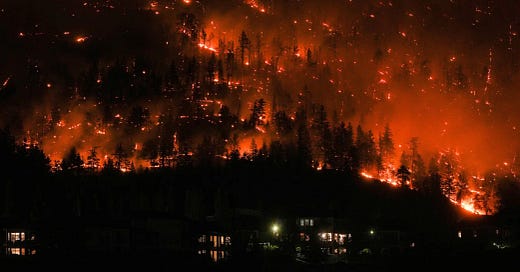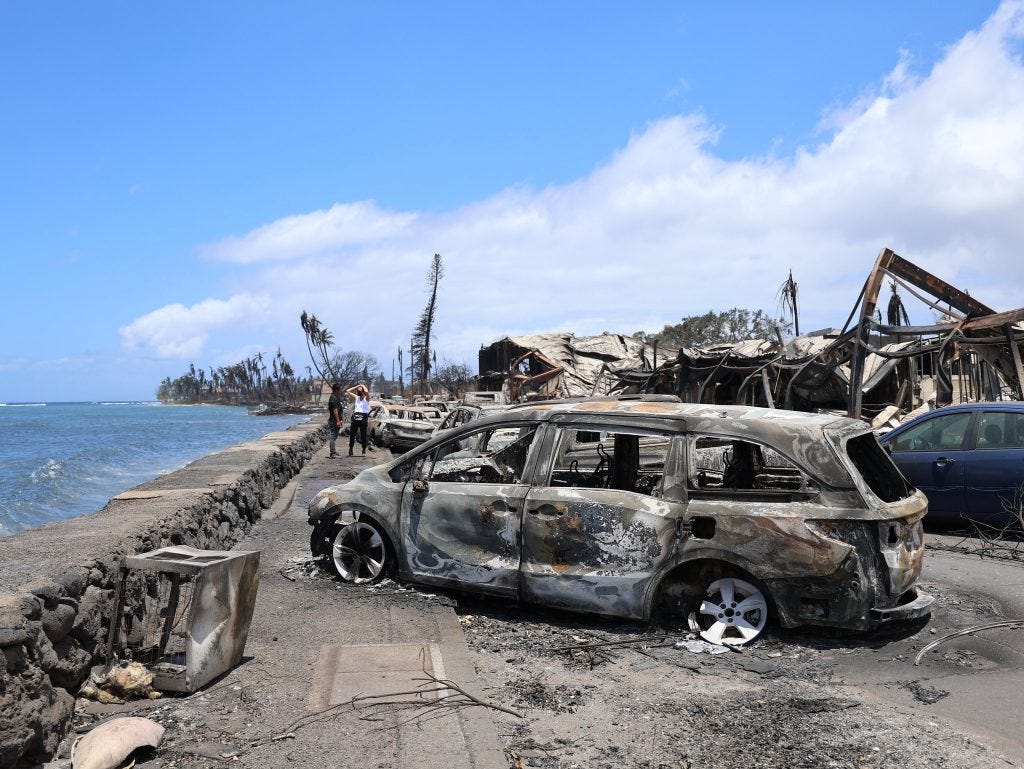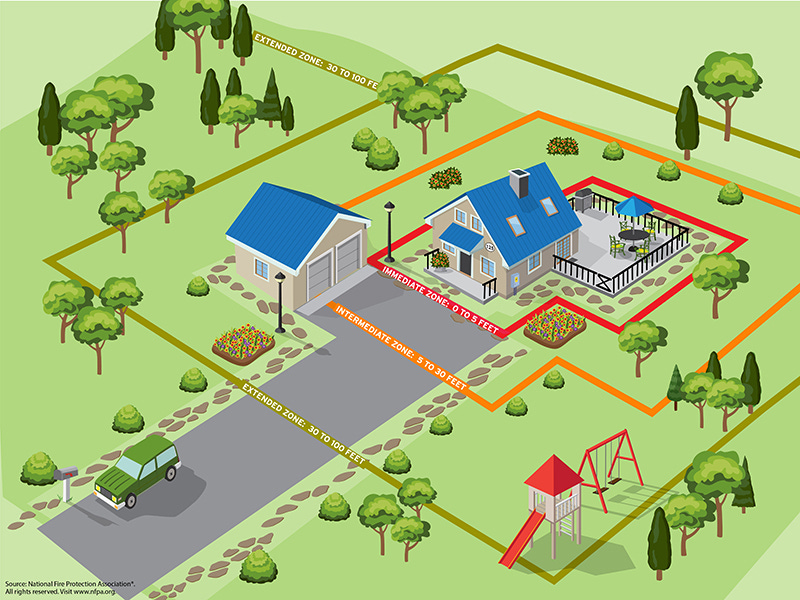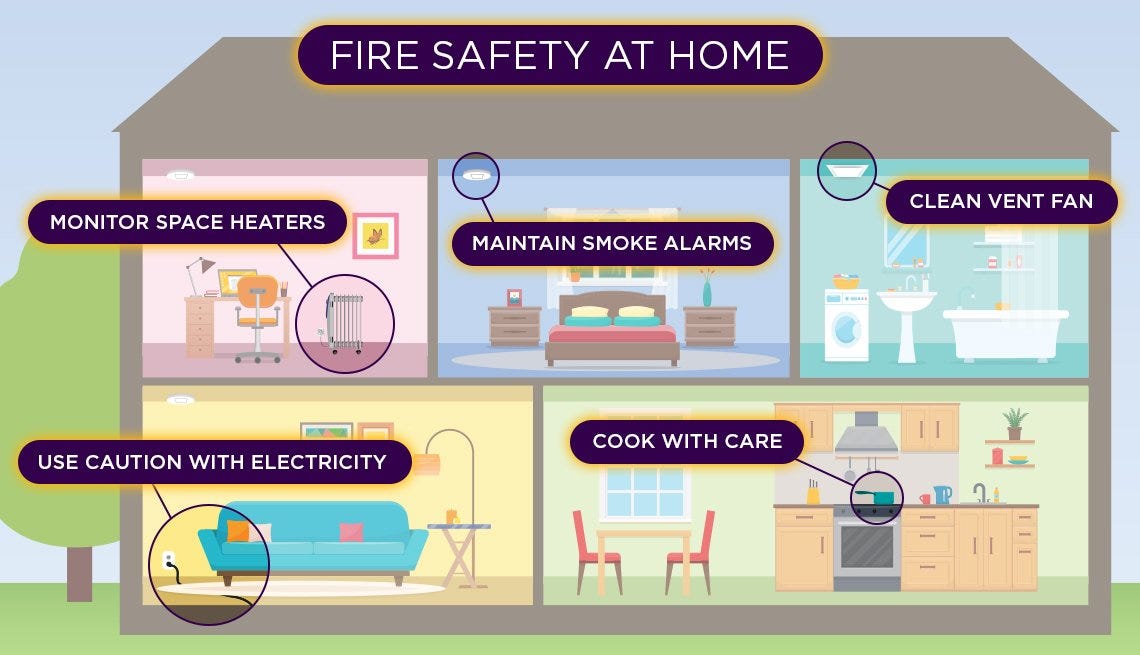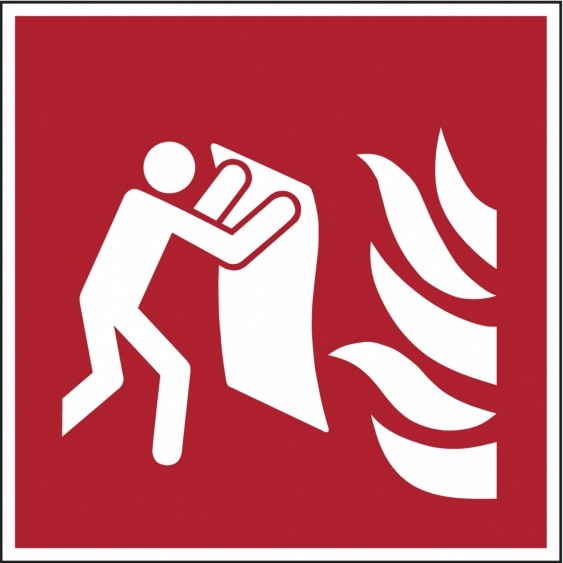The Government will not Save you!
Comprehensive Guide to Fire Mitigation and Protection Strategies for Home and Personal Safety
Canadian Wildfires - Photo Credit: Darryl Dyck
This year whether natural or man-made seems to be the year of fire. From Canada to Greece, Maui to New York City, fire seems to be sprouting up everywhere. What’s going on these days is nothing short of a tragedy, especially when you read about antiquated electrical infrastructure & outright failure/inaction of the government entities entrusted to provide a safe & secure living environment for its residents. After all, where do all those local tax dollars go? Didn’t the Biden Administration pass a Bipartisan Infrastructure Law in 2022? Oh yes it did.
The Bipartisan Infrastructure Law -
The Bipartisan Infrastructure Law promised the following:
Overall, the Bipartisan Infrastructure Law represents historic progress, as the largest and most significant investment in:
Rebuilding our roads and bridges since President Eisenhower’s Interstate Highway System;
Public transit in American history and an historic investment to make public transportation accessible;
Passenger rail since Amtrak’s inception, 50 years ago;
Clean water infrastructure;
Affordable, high-speed internet;
Tackling legacy pollution and advancing environmental justice;
Upgrading the power grid to transmit more clean energy and withstand extreme weather;
Increasing our infrastructure’s resilience against the impacts of climate change, extreme weather events, and cyber-attacks;
Replacing dirty diesel buses with clean, electric buses across school bus and transit fleets; and,
A national network of EV chargers in the United States and largest investment in domestic manufacturing of batteries and the critical minerals that power them.
To date (February 2023), the Administration has announced nearly $200 billion in funding and over 20,000 projects or awards, which are highlighted in a new map showcasing all projects and funding awards in all 50 states and territories. These awards and projects touch over 4,500 communities.
$200 BILLION. Have you seen any improvements in your area? These were the improvements according to the update per state PDF supposedly made in Hawaii as of February 2023:
Announced funding to date: approximately $13.1 million has been allocated to Hawaii for clean energy, energy efficiency, and power in 2022 and 2023. This includes:
$3.6 million for weatherization;
$3.5 million through the State Energy Program;
$2.9 million through the Energy Efficiency and Conservation Block Grant Program;
$3.1 million to prevent outages and make the power grid more resilient. Additional grid funding will be made available in the coming months. White House.gov
Where exactly did the money go? They must’ve skipped Lahaina, Hawaii.
Photo Credit: HI Governor’s Office
The Government Failed Maui
Here’s what one Lahaina resident had to say about the electrical infrastructure & the recent disaster:
“First let me start off by saying Lahaina is a desert climate and has been since plantation owners rerouted the water source to other parts of the island. Lahaina used to be a lush landscape. The infrastructure has largely remained the same since its inception. This means a cluttered nest of wires and rotting buildings. We have fires every year due to fallen electric lines. This isn’t something new.
In my opinion, this disaster could’ve been completely prevented had they spent the money to upgrade to in-ground electric lines. Many have asked over the years but were told there was no funds to do it. It’s a lot easier to secure funding after a disaster. At the very least, HECO (the electric company) could’ve cut the power a lot sooner. HECO CEO Shelee Kimora claimed it could’ve affected specialized medical equipment. This is crazy considering you can’t use medical equipment if it’s incinerated by a fire. Just another excuse to avoid accountability.
The state of the art “all hazard” sirens never went off. Herman Andaya (Maui EMA director) who was in charge of making the decision to turn on the sirens said he didn’t regret it. The next day he resigned due to “health issues”. No cell service and no loudspeaker either. There was no warning of any sort. People were in their houses and completely unaware until it the fire was close. There was a fire earlier and the Maui Fire Department said it was “100% contained”. The police allowed incoming traffic into the town coming from Kaanapali but closed the road off on the other side due to a downed line that wasn’t even blocking the road. This caused a gridlock. Residents' water was turned off with no way to protect their houses. Firefighters ran out of water and were denied access by Kaleo Manuel (DLNR’s deputy director for water resource management) until it was too late. This unnecessarily put firefighters at even greater risk. Original Tweet
From reading this resident’s testimony, we can scrutinize the highlighted information regarding the fire/electrical grid:
Local Government/Utility Services -
Failed to upgrade the electrical infrastructure despite prior knowledge & commonplace of electrical fires.
Placed the blame on “lack of funding” & needing a “disaster” to bring funding awareness to the issue.
Failed to shut off power supply to antiquated “nest of wires” power lines.
Shut off water supply to residences - this decision should have been left to individual households & most certainly firefighters
Unreliable cellular coverage in disaster situations
Local & Federal Government/Emergency Services -
Intentional failure to alert the residents of life-threatening hazards.
Poorly handled road closure & traffic congestion situations
There were many other failures I could go over but for this Substack, I’m going to stick with the failures which led to the fire hazards.
Fire Mitigation Strategies for Your Home -
Creating effective fire and water barriers around a home is essential to enhance its protection. Here are some natural barriers you can consider:
Fire Barriers Outside the Home:
Defensible Space: Clearing away flammable vegetation, dead plants, and debris from around the home creates a defensible space that helps prevent the spread of fire to the structure.
Fire-Resistant Plants: Choosing fire-resistant plants that have low flammability and high moisture content can act as a buffer between the home and potential fire sources.
Rock and Gravel Zones: Creating areas with rocks, gravel, or non-combustible materials can help prevent the spread of fire by reducing the availability of flammable materials.
Irrigation: Proper irrigation can maintain the moisture levels in vegetation, making it less susceptible to ignition.
Mulch Management: Using non-flammable mulch or rocks instead of flammable materials can help create a fire-resistant barrier.
For more details, check out this highly informative NFPA Guide.
Image Credit: AARP
Fire Mitigation Strategies Inside the Home:
Smoke/Carbon Monoxide Alarms & Detectors: Install smoke & carbon monoxide alarms on every level of your home, especially in or near bedrooms. Regularly test them and replace batteries at least once a year.
Fire Extinguishers: Keep a fire extinguisher or fire protection blankets in key areas, such as the kitchen & garage. Learn how to use them and ensure they are regularly checked and maintained.
Cooking Safety: Never leave cooking unattended, especially when using stovetops. Keep flammable materials away from open flames, & use a timer to remind you of cooking times.
Electrical Safety: Check cords and outlets for signs of wear or damage. Avoid overloading outlets or power strips. Unplug appliances when not in use.
Candles and Open Flames: Use caution when using candles, and always place them in sturdy, non-flammable holders. Keep them away from curtains, papers, & other combustible materials.
Heating Appliances: Keep space heaters and other heating appliances away from flammable materials. Maintain a clear space around them, & turn them off when not in use or when you're leaving the room.
Fireplace Safety: Use a fireplace screen to prevent sparks from flying out. Have your chimney inspected & cleaned regularly to prevent buildup.
Appliance Maintenance: Regularly clean & maintain appliances, especially dryer vents, to prevent the accumulation of dust and debris that could pose a fire hazard.
Smoking Safety: If you smoke indoors, use deep, sturdy ashtrays & ensure cigarettes are fully extinguished. Ideally, smoke outdoors.
Escape Plan: Develop a fire escape plan that includes multiple exit routes from each room. Practice the plan with your family regularly.
Fire-Resistant Materials: Consider using fire-resistant materials for curtains, upholstery, and other furnishings to reduce the spread of flames.
Childproofing: If you have young children, childproof your home to prevent them from accessing matches, lighters, & other fire-starting items.
Flammable Materials Storage: Store flammable liquids, such as gasoline and cleaning supplies, in well-ventilated areas away from heat sources.
Home Wiring: Make sure your home's wiring is up to code & properly installed by a professional to prevent electrical fires. Make sure you aren’t plugging in too many draws on one outlet.
Fire Ladders: If your home is more than one story, have a fire escape ladder in at least one of the upstairs bedrooms. This way you won’t have to risk breaking any bones/injury jumping.
Kitchen Safety: Keep a lid or baking sheet nearby when cooking on a stovetop. If a grease fire occurs, slide the lid or baking sheet over the pan to smother the flames, and turn off the heat.
Home Security: Install a security system that includes smoke & fire detection. This can help alert you & emergency services quickly in case of a fire.
Regular Inspections: Regularly inspect your home for potential fire hazards, such as frayed wires, faulty outlets, & gas leaks.
Important Document Protection: make sure to protect your most important documents & keepsakes in a fireproof & waterproof safe. Make sure to have backup copies of all your important documents off-premise (if electronic make sure it is encrypted or requires multi-factor authentication to access).
Protecting Your Body From Fire -
Stay Low: If there's smoke, stay close to the ground where the air is less toxic and cooler. Smoke and toxic gases rise, so crawling low can help you breathe more easily.
Cover Your Mouth and Nose: Use a cloth, scarf, or any fabric to cover your mouth and nose. This can help filter out some of the smoke and toxins from the air.
Wet Cloth: If possible, wet the cloth you're using to cover your mouth and nose. This can provide additional protection from smoke inhalation.
Check Doors: Before opening any doors, touch them with the back of your hand. If the door is hot, do not open it. Heat is an indication of fire on the other side.
Close Doors: If you're moving through a building, close doors behind you as you go. Closed doors can help contain the fire and slow its spread.
Find an Exit: Use your pre-planned escape route to find the nearest exit. If your primary route is blocked, use an alternative route.
Do Not Use Elevators: Elevators can become dangerous during a fire and may stop working. Always use stairs for escape.
Stay Calm: Panic can hinder your judgment and slow your escape. Keep a clear head and focus on the steps you need to take.
Signal for Help: If you're unable to escape, signal for help by waving a cloth or flashlight near a window. This can help firefighters locate you more easily.
Emergency Contact: If possible, call emergency services to inform them of your location and situation. Provide as much information as you can about your whereabouts and the fire's location.
Stay Away from Windows: If you're trapped on an upper floor, do not break windows to escape unless you have an escape ladder or safe way down to the ground. Smoke and flames can be drawn towards the broken window, putting you at further risk.
Use Fire Escape Masks: Fire escape masks are designed to provide limited protection against smoke inhalation and can buy you some time to escape.
Drop and Roll: If your clothing catches fire, remember to stop, drop to the ground, and roll to smother the flames.
Fire Escape Blanket or Cloak: the aforementioned fire blanket or even a fire cloak may prevent you from burning if you wear them.
Stay Together: If escaping with others, hold hands or stay close to ensure everyone stays together and doesn't get separated.
My fellow Warriors know we have to be self-sufficient as best as possible. We cannot rely on government/emergency services to help us in times of crisis. Of the many Lahaina residents’ heart-breaking testimonials I’ve watched over the past several days one consistent message stood out, community. Community members helped each other way quicker than any government or emergency personnel. If some of the aforementioned tips will help you & the Warrior Insights community, I will be achieving my mission here.
Until next time, stay informed, stay vigilant, Ever Forward!
P.S.: If you missed my Bill Gates’ Bio Mosquitos & the Reemergence of Malaria article, check out my video:
